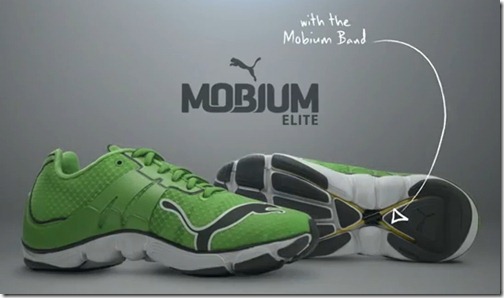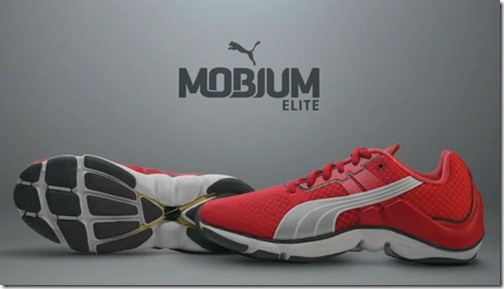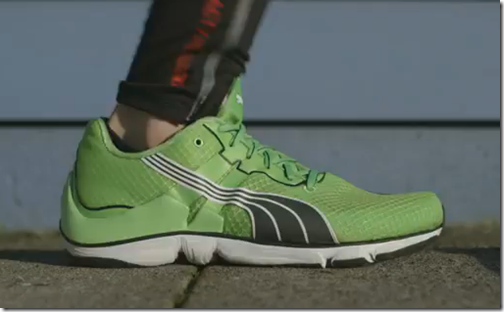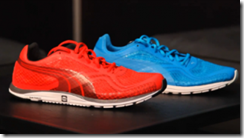A Facebook friend (thanks Joel!) just sent me a link to a really well-designed website for a new shoe that was just released by Puma. The shoe is called the Puma Mobium, and it has a sole that can apparently spread out to increase width on contact. Interesting concept – I’ve never tried a Puma shoe so this may be my first if I give the Mobium a go. No idea on specs, if you have any info feel free to leave a comment.
(As a side note, the slow-motion video of the runner featured on the site is awesome, and he’s a great example of an asymmetrical footstrike pattern)
Here are some photos of the shoe from the Puma site:
Below are a few videos about the design of the shoe:


















Very interesting. I really am looking forward to more info and feedback on this shoe! Never worn a Puma either but nice looking shoe! YES! Loved the slow-mo video on their site, was having a blast moving the runner back and forth along his stride, actually one of the best demonstrations of good form in a video I’ve seen, and interactive!
Honestly the slow mo runner is the bestirs of the entire site, I was doing the exact same thing making him go forward and backward :)
I lost interest as soon as the lady in the first video described proper form by landing on the heel.
Yeah, same here.
She was referring to walking, not running, which is pretty standard. That’s the impression I got, at least.
She said “Your typical walking motion or running motion comes in”…
Interesting
Looks Interesting!
It was interesting to see this. I have not worn Puma’s myself since I was a kid in NY in the 70’s and Walt “Clyde” Frazier (of the NY Knicks) was playing and had the popular Puma model named after him.
I also noted the differential in the runner’s strike that Pete mentions above as I was slowly dragging the image back and forth on their site. His right foot has a definite heel strike and the left foot a forefoot strike. Interesting.
The Puma web site location where you can buy the shoe (http://www.roadrunnersports.co… indicates a weight of 8.5 oz, but no offset information.
As Richard notes below, I also found it interesting and paradoxical to hear the woman in the video make specific note of heel strike form, when the Puma web site seems to suggest that the shoe is designed more for a midfoot strike.
From my research about 5% of runners have an asymmetrical foot strike. I agree on the heel strike comment – doesn’t seem to match why they seem to be trying to show in the videos.
That’s interesting Pete. Is the difference attributable to strength/flexibility issues? When I first saw the video, my mind said “He has a mild foot drop on the left side”, which would be a neurologic issue. But upon closer inspection, I am not sure if that is the case.
Probably lots of reasons. Neurological, anatomical asymmetry, flexibility difference, injury compensation, restriction do to a past injury, etc. I think we are all probably a bit asymmetrical, just doesn’t always show up as a discrete pattern like in the guy in the video.
We have the shoe in stock at the Cleveland Running Company. It’s interesting, but maybe not so much for those who subscribe to the less is more philosophy. Very comfortable, if not overly cushy, fit out of the box (I haven’t run in them) I think the “technology” will intrigue people, and perhaps open the door to a discussion about running form and foot function; which, fortunately, is right in our wheel house! As far as the comment about heel striking… people are going to debate that until they are blue in the face. It’s really more important where your foots lands than what part of your foot makes contact with the ground first anyway (in my opinion…)
I agree, I’m not as bothered by the heel strike comment as I would have been a few years ago.
Does the sole actually spread when you compress it?
Ehhh… the feeling of the band extending may give a false sense of this, but I’m not convinced this actually happens. I will take them for a spin tomorrow and let you know what I feel.
After a quick jog in them today, I can say that the sole doesn’t spread on compression, but the way the band system works I can see how some might feel like it does… I’m surprised how much I liked the way the shoe felt on the jog though… didn’t expect to like it as much as I did.
I like the flexibility. More and more to me that seems like a must have.
Looks really cool…just hope that it’s a low drop shoe with bigger toe box than other puma shoes.
yea…lost interest when the lady mentioned landing with the heel first
heel STRIKING is bad
however, landing under the center of gravity with a forefoot, midfoot, or heel CONTACT is fine, just as long as there is no striking going on
but yea, meh on the shoe
Nobody lands under the center of gravity when running at a steady state, it’s physically impossible to do so.
The reality is that closer you land to your center of gravity the shorter you time on stance goes, and the higher your peak loads and loading gradients are. The only way to avoid the increase in peak loads is to reduce the time in air by the same % as the reduction in time on stance, even with this the loading gradients still go up.
If you want to reduce loads and avoid striking the ground on landing then the key is reduce the time in air and not short change time on stance. This is true regardless of foot position on landing.
If you look at barefoot runners you’ll find as a population they reduce their time in air far more than they reduce time on stance, the body naturally does this is reduce the peak loads and loads on landing. Low mass at the foot when barefoot helps reduce the costs of this quick turnover.
I’d qualify that by saying heel striking can be bad for some people. Some people seem to get by just fine with a heel strike. Very much depends on the individual.
I think they get by fine for while. It eventually catches up to them though. They’re the ones complaining about knee and hip pain going into their forties.
It may, it may not. People tolerate stresses applied to the body differently. I’d venture to guess that if you filmed people who have been running for decades without injury you’d see form all over the map. But, if you’re treating a patient with knee trouble, foot strike and placement are certainly things to look at.
—-
Pete Larson’s Web Links:
-My book: Tread Lightly: link to ow.ly
-Blog: https://runblogger.com
-Twitter: link to twitter.com
-Facebook Page: link to facebook.com…
-Discussion Forum: https://runblogger.com/forum
Interesting, but I can’t deal with any rubber/plastic wrapping around the inner foot. Can virtually guarentee those three green teeth on the inside will bite.
Yeah, I worry. About that too
It’s actually quite comfortable.
The shape seems to mimic the skeletal structure of the foot, with the mechanics looking to work something like how the arch of the foot will compress a little when loaded, and there’s almost a plantar fascia looking structure in the sole. I have to admit that it’s certainly a nifty looking design.
I always find it interesting shoe companies bring out their artsy designers for these videos. Cat paws?…I don’t want a shoe designed by people with a graphic design degree. I want a shoe made by kinesiologists and biomechanists. Sure, new concepts sell shoes- but it’s about time we get shoes that actually work to prevent injuries instead of causing them.
I fear the result if shoes were produced by biomechanics you might have just as many complaints – not always a lot of agreement among scientists on what is best. The shoes would also be hideous :)
Beauty is in the eye of the beholder. Math equations can be as beautiful as sunsets and flowers.
For running shoes, the beholder needs to make a purchase. Like it or not, a shoe company has no incentive to make a shoe that will not sell. The best approach is to get designers and biomechanics experts to work together, and we’re seeing that occurring more often. Saucony is a good example – spent a day at their HQ and much of it with their biomechanics guy. The lab is like 10 feet from where the designers work – lots of interaction.
—-
Pete Larson’s Web Links:
-My book: Tread Lightly: link to ow.ly
-Blog: https://runblogger.com
-Twitter: link to twitter.com
-Facebook Page: link to facebook.com…
-Discussion Forum: https://runblogger.com/forum
I might be the exception but I have never bought running shoes based on its looks. Ugly didn’t seem to slow the VFF sales.
Because not everyone thought the VFFs were ugly. They had a weird, cool, unique factor as well. You have to keep in mind that most running shoes aren’t even bought by runners, and looks are probably the number 1 factor overall that leads to shoe purchases. We may not like that, but it’s the reality of the business.
—-
Pete Larson’s Web Links:
-My book: Tread Lightly: link to ow.ly
-Blog: https://runblogger.com
-Twitter: link to twitter.com
-Facebook Page: link to facebook.com…
-Discussion Forum: https://runblogger.com/forum
I’ll pass on these as well mainly because I think it’s yet another piece of technology that is created to supposedly mimic the natural action of the foot yet ends up doing the opposite.
An elastic band that “snaps” back into place on toe off is redundant since this is what our feet with it’s articulating joints, layers of muscle, and the plantar fascia, tendons, and ligaments are designed to do. It will return to its original state when it needs to without any external help.
In the videos, the sense I am getting is that they’re excited about the Mobium not because it helps running but because they are first to market. Maybe it’s just the cynic in me. :)
Lastly, I wish they would stop showing the runners stopping in the middle of their runs to perform static stretching.
There is no ‘snapping’ of the band. You can’t even feel it – the shoe is incredibly comfortable and it helps me run better. Isn’t that what a running shoe is supposed to do? And heave forbid it actually looks good too.
I don’t “buy” this. The only reason why it expands is because it’s an arch when unloaded. No foot looks like this! With an 1 inch gap below. If anything it should rise only on the inside side of the foot.
To me it looks as an equivalent of Nike Free from Puma+some marketing story and styling (ie the band) to support this story.
It looks a lot like the Mizuno Levitas with that gap under the arch
Why have a shoe when you can have another foot?
I lost interest as soon as I heard the word “shoe”.
I may check these out. There is a Puma flagship store a few miles away. I have a few pairs of the Puma’s FAAS running series and like them.
I feel like this is the Adidas Torsion bar rebooted
Hi
Proof will be in the pudding, I guess the shoe catches the eye and will get you to try the product on, that is always the first step, it must attract you which this shoe certainly does. Then it has to work for you. No matter what anybody says about anything you will know after running it a few times what is what.
I find it quite really interesting how quickly we all are to judge something without giving it a chance, just because its different doesn’t mean it won’t work.
The updated Faas 500 V2 is an amazing shoe in my opinion and has a really low 4mm HTD with enough cushioning too, these guys are getting serious again about performance footwear. I am a fan
Mobium marketing is telling is “new” and the first shoe that it mimics the foots plantar fascia… Umm… anything like the “Fascia Band” in many old Inov-8 shoes???
The problem is both are not good for your feet. The approach can lead to the foots arch flattening out more than if walking/running directly on the ground thus putting more load on your plantar fascia.
Personally I find that if I run in my Inov-8 shoes without the “Fascia Band” – my Trailrocs and Bare-X’s my plantar fascia injury slowly recovers, but if I go back to my old Roclite 295’s with “Fascia Band” it aggravates the plantar fascia injury.
I would expect these shoes to be even worse as the soles look softer and would just shear under foot not provide good support.
I honestly didn’t even pay attention to the PF mimicking aspect of these shoes, I just was intrigued by the idea that they might spread out mediolaterally when loaded. I tune out most of the marketing spin :)
I think this may be a jump to the next shoe fit paradigm. I can imagine a diverse selection of these shoes with varying levels of stiffness in that band…which makes more sense than the pronation paradigm.
It is very interesting that they study the paws of big cats to come to the conclusion that a human foot change shape when running or walking. I know a much easier way.
I filmed my daughter’s foot splaying barefoot a few years ago, maybe I should have patented it ;) Imagine that, film a human foot to design a shoe for a human foot! link to youtube.com…
—-
Pete Larson’s Web Links:
-My book: Tread Lightly: link to ow.ly
-Blog: https://runblogger.com
-Twitter: link to twitter.com
-Facebook Page: link to facebook.com…
-Discussion Forum: https://runblogger.com/forum
Inspiration to create a shoe for a two-legged, full-foot walking (plantigrade) animal (or God’s creature, as you wish) – that is the man – based on a four-legged toe-walking (digitigrade) animal – that is the cat surely sounds catchy, but is it a valid approach? The gentleman below seems also to wonder… :)
I tried out the mobium in a Puma store yesterday. The first thing I noticed is that it does return energy to your step. The basic premise seems to have merit.
Other aspects of the implementation have ruled out this iteration for me though. I noticed that energy return cords looked like bungee cord; I hope that it would maintain durability. I disliked the upper. I found it constricting on the mid through the forefoot. The 8 mm drop for me is another deal breaker. I’m very happy with 4 mm (Go Run Rides/Kinvara), and double that is very noticeable, but YMMV. I also noticed some slippage around the heel.